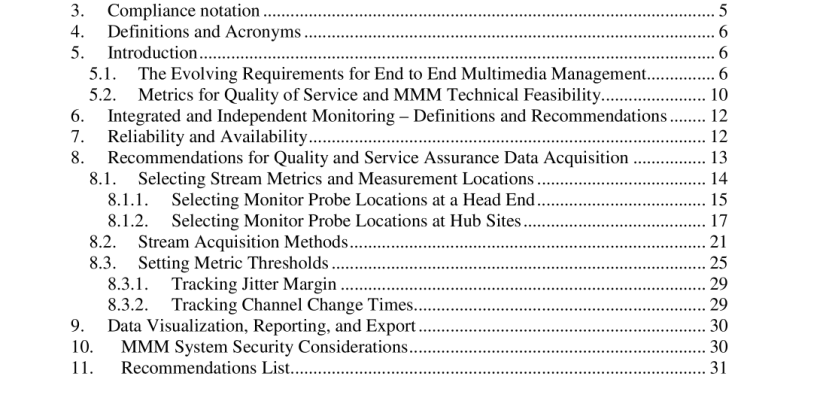ANSI SCTE 168-6-2017 pdf download.Recommended Practice for Monitoring Multimedia Distribution Quality
Operators face an increasingly competitive multimedia distribution landscape which increases the demands for operations efficiency. Successful, cost-effective, and reliable high quality delivery of thousands of media streams through dozens of network processing equipment nodes in a delivery network to hundreds of thousands to millions of subscribers requires an automated quality assurance system. The quality assurance system must correlate per-program impairment events throughout the network to provide an intelligent view of performance data to operations personnel in order to minimize maintenance expenses in detecting, locating, and repairing faults. Today’s modern dynamic and growing physical IP plant deployments along with a growing subscriber base demands this to maintain an operator’s competitiveness. For most deployed multimedia systems designs relying on highly compressed video streams such as MPEG 2 or MPEG 4 AVC, even a single uncorrected IP packet loss on a viewed stream likely results in a customer perceivable impairment.
Stream processing devices as shown in HMS 159 are often supplied with management tools that describe the health and diagnostic results of that element. For example, the parameters described in the HMS 154 encoder MIB (& other HMS MIB examples) shows how a device is configured for stream bit rate, compression algorithm type, coding delay, enabled/disabled status, PID assignments, Port and Protocol status, Up/Down input stream status, input clock sync, input/output amplitude levels. However, per-PID compliance monitoring employing information such as described by SCTE 142 Transport Stream Verification and flow monitoring such as described in RFC 4445 is not usually included – that is, it has been too costly and complex for every processor device to incorporate per PID analysis (Transport Stream Verification) for all PIDS processed. Yet, to keep costs in check, an operator must know immediately if transient PID issues occur, must know where they occur, and must have network visualization tools that allow correlating issues for fault isolation and for cost effective troubleshooting dispatch. Without such tools, the operations staff is reduced to best guesses, random interconnect and device replacement, switch/router configuration and tuning with no way to measure results. Quick problem resolution and root cause analysis using these measurement and analysis methods allows the operator to improve customer satisfaction and reduce churn.
In Figure 1, each colored horizontal line of boxes represent a single IP packet with each box representing a single MPEG Transport Stream packet. The uncolored boxes to the far left shows statistics on the IP packet to its right including, from top to bottom, the ordinal number of the packet in the analyzed file, the RTP payload type and the RTP sequence number (if RTP is used), and the elapsed time since the previous packet was received in seconds. Within each TS packet box, a number of parameters are shown including the PID number to which the packet belongs, the Continuity Counter value, the type of data in the packet, etc. It can be seen in these few packet captures that the type of data in any given IP packet varies widely. For example, in the first IP packet of the 2 nd capture, there are no video packets at all – only MPEG-2 NULL packets (labeled as stuffing) and audio where in the last IP packet of the 1 st capture, there are 6 video packets and 1 audio packet. From the above analysis it can be seen that the effects of a single lost IP packet will vary but will nearly always carry some video since video is, by far, the highest bit rate content and thus occurs most often in the stream. Of course some video packets impact the picture quality more than others and that impact is dependent on the type of pictures and the type of program being carried at that instant.ANSI SCTE 168-6-2017 pdf download
